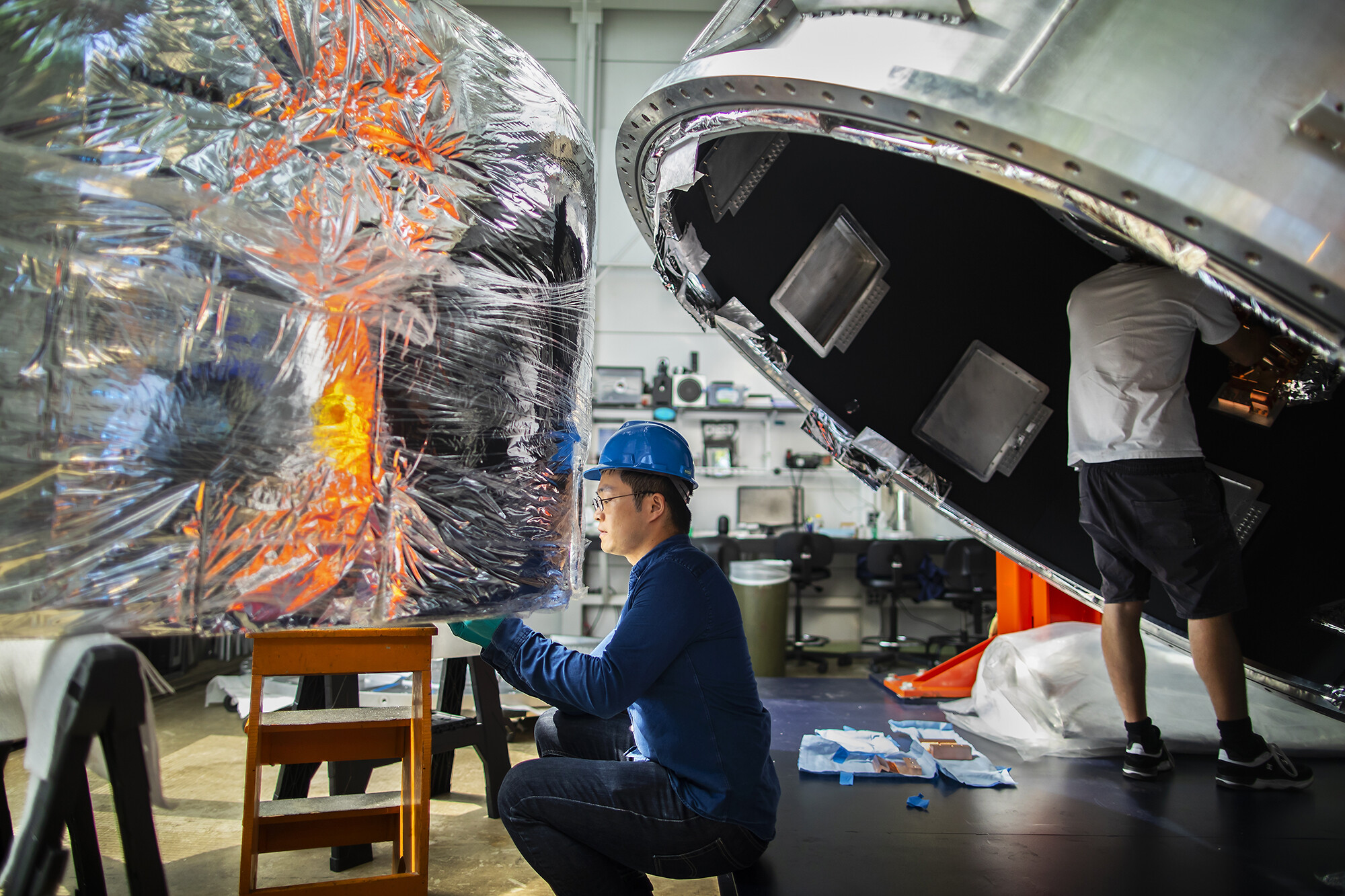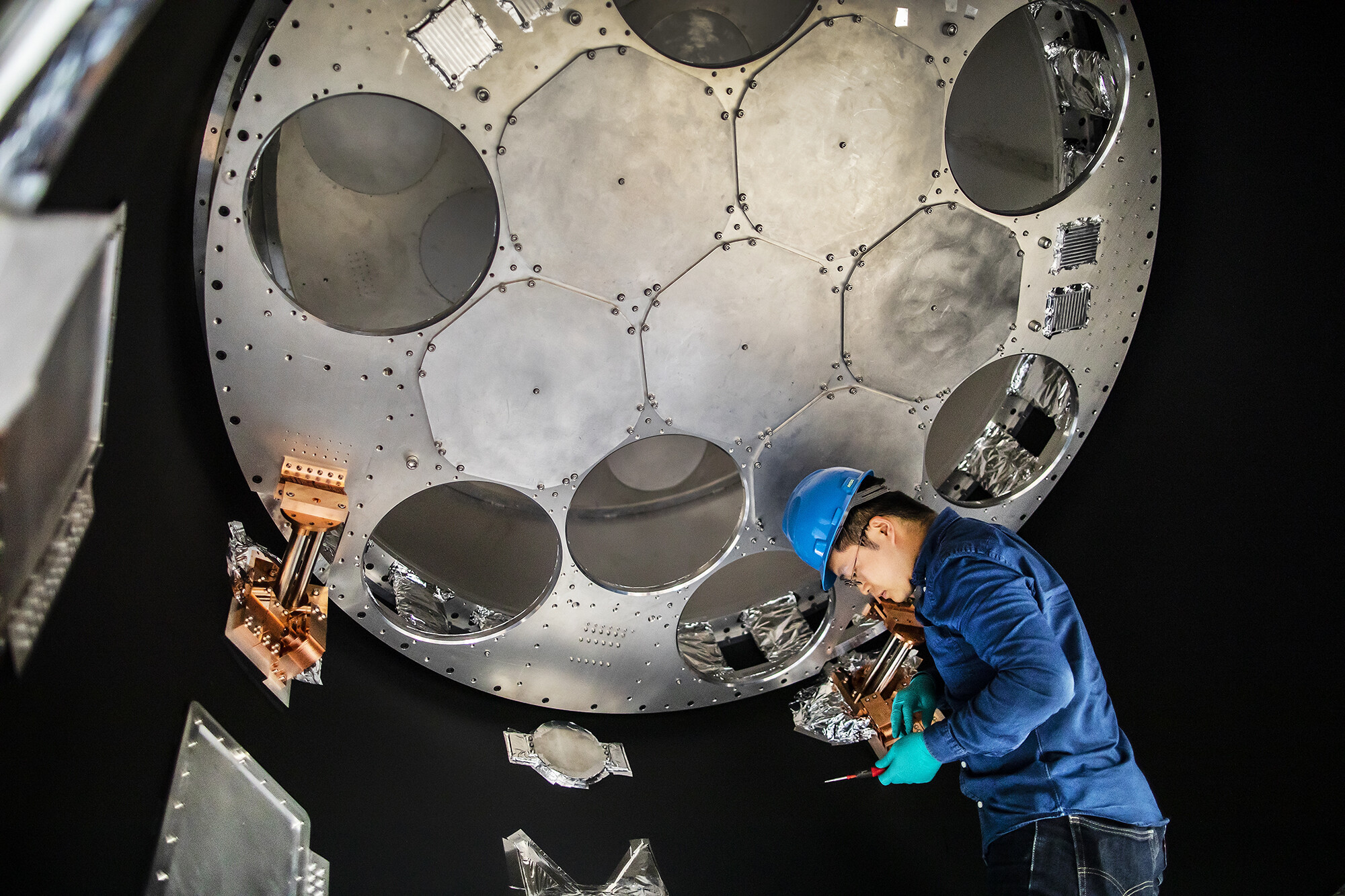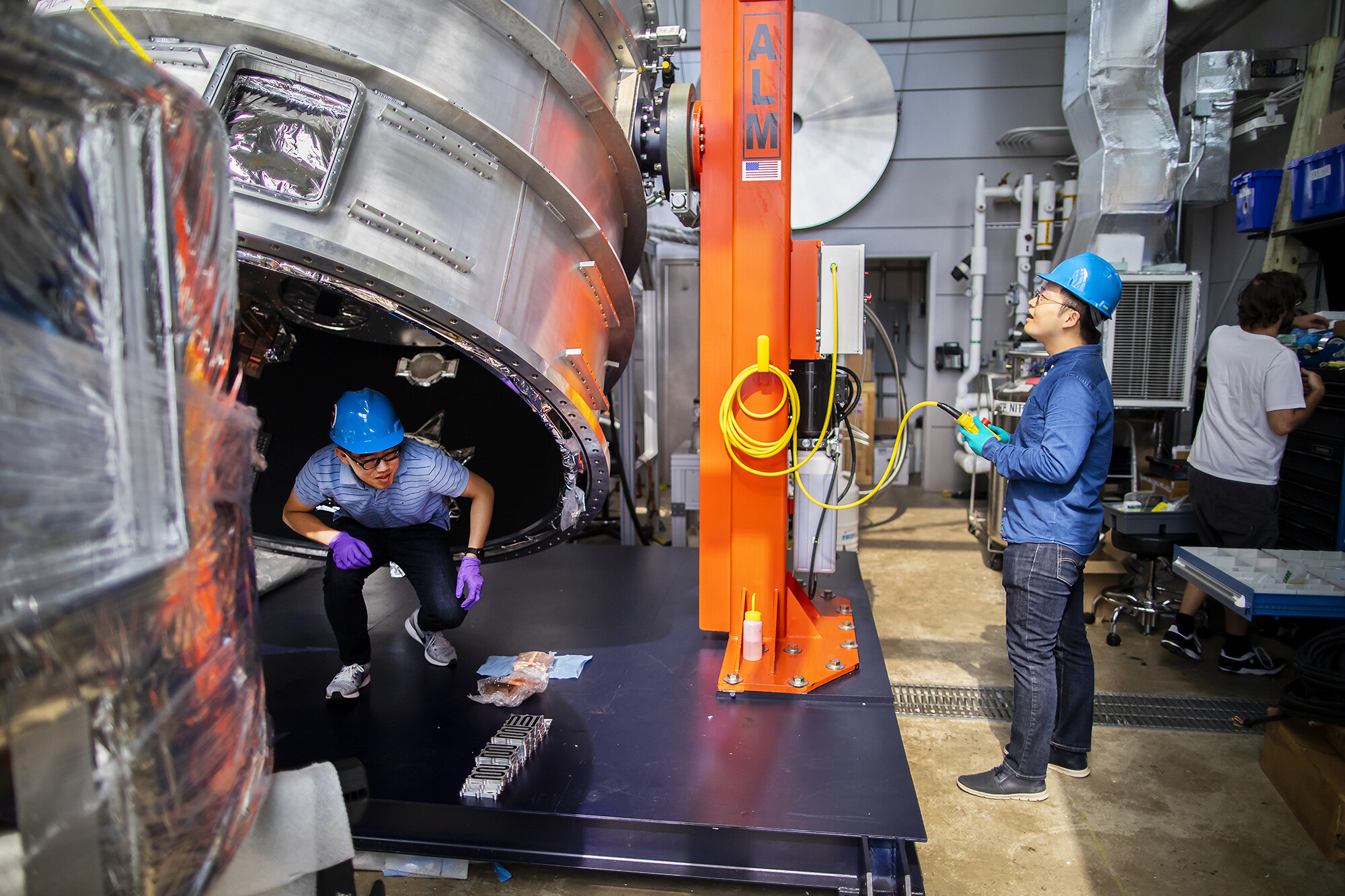
(From left) Doctoral student Hannah Yamagata, research assistant professor Kushol Gupta, and postdoctoral fellow Marshall Padilla holding 3D-printed models of nanoparticles.
(Image: Bella Ciervo)

On a hot morning in early July, a seven-foot wide, 8,000-pound metallic structure made its way from Boston to Penn’s David Rittenhouse Laboratory. The large aperture telescope receiver (LATR) was carefully loaded onto a forklift and carried through narrow alleyways and parking lots before being placed in the High Bay lab, while students and researchers watched in eager anticipation.
But now is when the work, and the fun, truly begins. As members of the Simons Observatory collaboration, researchers in the lab of Mark Devlin are now putting the finishing touches on the LATR, the sensor that will be the “heart” of a cutting-edge astronomical observatory whose goal is to learn more about the early moments of the universe.
The Simons Observatory will include a series of telescopes, located in the high Atacama Desert in northern Chile, that are designed to detect cosmic microwave background (CMB). CMB is the residual radiation left behind by the Big Bang, and astronomers study these faint waves to learn more about the first moments of the universe, nearly 14 billion years ago. By studying this “afterglow” of the Big Bang, researchers are hoping to learn more about the evolution of the universe over time.

“It’s like a fossil,” says Michele Limon, a systems engineer working on the Simons Observatory project, about how the CMB can help astronomers look back in time. Limon also says that the CMB could even be used in other areas of physics research, like measuring the mass of neutrinos. “The CMB is an amazing tool that lets you study all kinds of things,” he says.
But the challenge with measuring the CMB is that the signal is incredibly faint. “Because it’s so faint, we need to control the noise,” explains Zhilei Xu, a postdoc in the Devlin group. “And all of the electronics work better when they are colder. If it’s too hot, they are noisier.”
Cold, in the case of the LATR, means really, really, really cold. The CMB exists around 3 degrees Kelvin, nearly -450 degrees Fahrenheit. And because the Simons Observatory wants to study the CMB in the ultra-microwave range, they’ll need to make the detector even colder, down to 0.1 degrees Kelvin. For perspective, 0 Kelvin is called Absolute zero, the lowest theoretical temperature that isn’t actually possible to reach.
As experts in cryogenics, a branch of physics that deals with creating and studying things at very low temperatures, the Devlin group is working on creating the right type of super-cold environment for the detectors to find the CMB. Using their expertise, the group designed the massive metallic shell that will house all of the detection technology, with graduate students Ningfeng Zhu and Jack Orlowski-Scherer heavily involved in the design of the LATR.
“There is a limited cooling power of the fridge,” says Orlowski-Scherer about the ultra-cold fridge that will go inside the LATR. “We had to design the instrument in a way that could match what the cooler was able to put out. Staying under the limit meant careful design,” he says.
As the largest ground-based CMB experiment ever built, twice as big as previous observatories, Zhu says that the design process involved addressing a number of engineering challenges. The amount of time spent working on the design and the anticipation of waiting to see whether the LATR could hold up under vacuum pressures were “exciting, challenging, and rewarding,” he says. “It’s a once-in-a-lifetime opportunity.”

The Devlin lab will spend the coming months running tests to make sure the LATR, the shell of which was fabricated in Boston with all components precise to 1 mm, works as it should before installing insulation, detectors, thermometers, and sensors.
In parallel, the large aperture telescope, LAT for short, is being produced in Germany with the aim of having both the LATR and LAT assembled and shipped to Chile in early 2021. The goal is for the observatory to collect its “first light” sometime in the spring of 2021.
Devlin, who has been working in this field for his entire career, says that the finished product will be 10 times more sensitive than any other CMB experiment he’s worked on. He says that with such a long-term project like this it’s hard to have a single aspect that he’s most looking forward to but says it’s “fantastic” to have the LATR here at Penn and to see the progress that’s being made every day.
“The short-term goals are based on tech, but the long-term goal is actually the science. We spend our time on the tech because, ultimately, you want to take sensitive measurements of the sky. And we’re going to be looking at cool stuff, the evolution of the universe over cosmic time, so just to see the results come in will be fun,” says Devlin.
This project is supported by the Simons Foundation and the Heising-Simons Foundation with additional support provided by the Dean’s Office of the School of Arts and Sciences. A complete list of collaborating institutions can be found at the Simons Observatory website.
Mark Devlin is the Reese W. Flower Professor of Astronomy and Astrophysics in the Department of Physics and Astronomy in the School of Arts and Sciences at the University of Pennsylvania.
Erica K. Brockmeier

(From left) Doctoral student Hannah Yamagata, research assistant professor Kushol Gupta, and postdoctoral fellow Marshall Padilla holding 3D-printed models of nanoparticles.
(Image: Bella Ciervo)

Jin Liu, Penn’s newest economics faculty member, specializes in international trade.
nocred

nocred

nocred